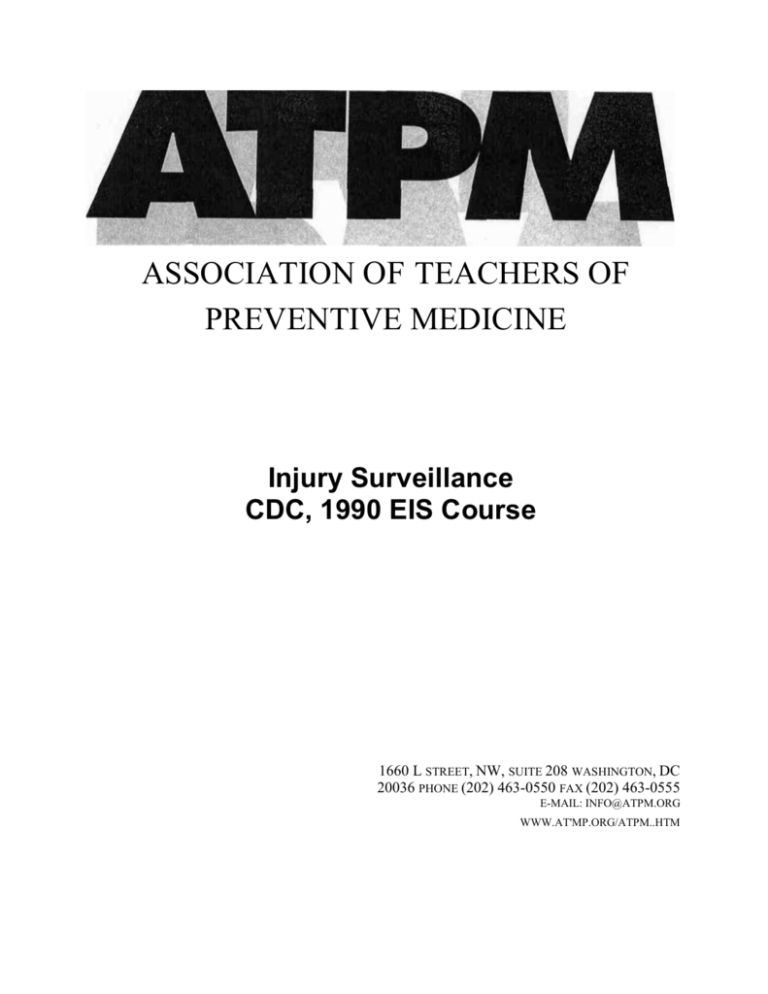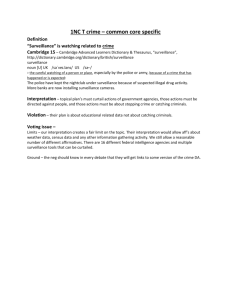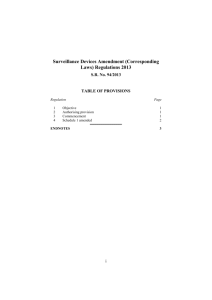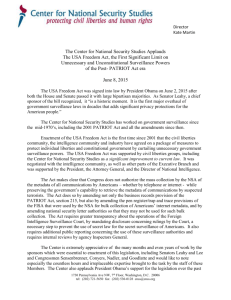1990 CDC/Emory Autumn Courses - Northwest Center for Public
advertisement

ASSOCIATION OF TEACHERS OF PREVENTIVE MEDICINE Injury Surveillance CDC, 1990 EIS Course 1660 L STREET, NW, SUITE 208 WASHINGTON, DC 20036 PHONE (202) 463-0550 FAX (202) 463-0555 E-MAIL: INFO@ATPM.ORG WWW.AT'MP.ORG/ATPM..HTM 1990 CDC/Emory Autumn Courses ESTABLISHING AN INJURY SURVEILLANCE SYSTEM Objectives By the end of this case study, the student should be able to: 1. List potential sources for surveillance data and recognize the strengths and weaknesses of these sources. 2. List the characteristics of problems/events for which surveillance would be useful and appropriate. 3. Calculate years of potential life lost. 4. Describe the decisions and trade-offs which need to be made in establishing a surveillance system. 5. Define sensitivity and specificity in the context of a surveillance case definition. Part I A recent EIS graduate was named as the new Director of the State X Division of Maternal and Child Health. One of her first tasks was to develop priorities for the Division and a strategy to address those priorities. She asks you to assist in developing a proposal for a childhood injury prevention program in the State. Your first task is to describe the magnitude of the problem of childhood injuries. QUESTION la: What existing sources of information about childhood injuries might be helpful in describing and assessing the problem of childhood injuries? QUESTION 1b: What criteria would you use in evaluating sources of health data? Evaluate the sources you listed according to these criteria. 1990 Autumn Courses: Surveillance 2 The only data readily available at the Health Department are age- and cause-specific injury mortality data published by the State Vital Registrar's office. An examination of these data for the past 10 years demonstrated the following: Table 1 Mortality from Childhood Injuries (up to age 19 yrs), State X, 1977-1987 External Injury Rate per 10,000 child-yrs (Age 0-19 yrs) Percentage of total injury deaths within age group_______ (0-5 yr) (6-12 yr) (13-19 yr) Burns 0.21 18.8 13.8 3.2 Drowning 0.31 16.3 18.1 8.9 Falls 0.10 11.2 3.4 1.5 Motor-vehicle occupant 1.06 9.2 11.6 60.8 Motor-vehicle pedestrian or cyclist 0.43 18.7 34.5 11.6 Poisoning 0.08 2.2 0.5 4.0 Suffocation 0.14 17.1 6.0 1.6 All other 0.22 6.5 12.1 8.5 QUESTION 2a: Based on the mortality data, which type of injury would you choose as a target for your prevention program? QUESTION 2b: What factors in addition to mortality should you consider in deciding which type of injuries should serve as the focus for a prevention program? 1990 Autumn Courses: Surveillance 3 A search for other data sources in State X reveals that the smaller of the two poison control centers in the State maintains some basic statistics on victims of childhood poisonings and that a few of the large hospitals have computerized discharge records. Additionally, some information on motor vehicle occupant injuries is available for the State from the National Highway Traffic Safety Administration. It becomes apparent that the currently available data would be inadequate for establishing and monitoring a prevention program. You suggest that the State establish a system of ongoing childhood injury surveillance. QUESTION 3a: What would be some of the potential uses of the surveillance data that could be used to justify the establishment of a new surveillance system? Considering the difficulty in establishing a new surveillance system, the MCH Director wonders whether it might be better to perform a baseline survey followed by a second survey after the intervention program had been in place for a couple of years. QUESTION 3b: Discuss the advantages and disadvantages of using surveys versus surveillance to collect the needed data. 1990 Autumn Courses: Surveillance 4 After additional discussions, the MCH Director was finally convinced that a surveillance system would be useful to monitor temporal trends of childhood injury and determine the characteristics of those at risk for being injured so that interventions could be more effectively targeted. However, the State Health Department has limited funds. To justify funding of the surveillance system, the MCH Director asks you to put the injury problem in a public health perspective. She suggests you calculate years of potential life lost for some of the leading causes of death. The following 1987 U.S. mortality data are available from the National Center for Health Statistics: Table 2 Selected Causes of Death by Age Group, United States, 1987 Heart Dis Age (in years) 0-4 5-14 Cancer Cerebrovasc Injuries Suicide Homicide HIV Infection (390-429) (140-208) (430-438) (E800-E949) E950-E959) (E960-E978) (*042-*044) X401,403) 1,272 649 181 3,871 0 607 191 1,138 73 4,198 251 407 47 324 15-24 1,062 1939 244 18,695 4,924 5,354 492 25-34 3,652 5,371 967 16,622 6,655 6,546 5,026 35-44 12,222 14,934 2,410 10,862 5,132 3,722 4,794 45-54 32,708 38,240 4,672 6,982 3,707 1,803 1,838 55-64 90,017 98424 11,488 7,825 3,650 1,204 761 65-74 178,072 149,046 27,767 8,686 3,428 763 230 75-84 178,072 120,765 52,330 9,929 2,402 449 73 8S+ Unknown 202,816 107 46,388 33 49,687 16 7,223 127 634 13 147 101 13 3 Total 760,353 476,927 149,835 95,020 30,796 21,103 13,468 QUESTION 4a: Which causes account for the greatest number of deaths among those under age 25? Which causes of death account for the greatest number of deaths among those under age 65? QUESTION 4b: Calculate and compare years of potential life lost (to age 65) for each cause of death in Table 2. 1990 Autumn Courses: Surveillance 5 Your efforts have resulted in a tentative allocation of funds for childhood injury surveillance. After considering several possible sources of surveillance data, you decide that hospitals and emergency rooms should be the primary sites for data collection because the yield would be highest from these sites. An expert panel is convened to discuss further details of the surveillance system. At the first meeting, the issue is raised of whether the surveillance should be active or passive. The MCH Director had initially envisioned a passive surveillance system in which the physicians who examine patients with injuries would fill out a brief reporting form on each patient seen; the forms would be mailed to the health department using an attached stamped envelope. The representative of the local chapter of the American Academy of Pediatrics suggests that such a reporting system may not work since the physicians who would be seeing the patients are too busy to fill out yet another form. He wonders if it would be possible to have someone from the health department call or come by each of the hospitals and emergency rooms every week and abstract data from the emergency room log or the patient charts. QUESTION 5: Discuss the relative merits of a "passive" system (where the reporting persons initiate reports on their own), as compared to an "active" system (where public health employees contact them to request reports) to collect data from these sources. The MCH Director states at that point that she does not know exactly the level of funding that would be available for injury surveillance, but she feels that it would probably be inadequate to hire enough staff to visit all the hospitals and emergency rooms in the State on a periodic basis. The MCH Director from the adjacent State, which has a childhood injury surveillance system in place, suggests using a sample of hospitals and emergency rooms for active surveillance. QUESTION 6: What are the advantages and disadvantages of including all hospitals and emergency rooms in your surveillance system as compared to a sample of them? If you do not use all the hospital and emergency rooms, how might you select your sample? 1990 Autumn Courses: Surveillance 6 After further researching the situation, the MCH Director decides to set up an active surveillance system covering residents of 14 counties, chosen because they represent a cross section of urban centers, suburbs, and small rural towns. The 23 hospitals to be recruited into the system account for 93% of the pediatric discharges in these counties. The system covers a population of 87,000 children and adolescents. The surveillance system is based on abstraction of all injury-related hospital discharge records and a systematic 25% sample of emergency room visit records from the participating hospitals. The abstraction is to be performed by two specially trained data collectors. At the second meeting of the expert committee, the proposed design of the system is reviewed and the case definitions to be used in the surveillance system are discussed. There is considerable debate about how a case should be defined. When the issue of spinal injuries was discussed, for example, the director of pediatric emergency services at the large public hospital suggests the following definition: "A person with acute traumatic injury to the spinal canal with evidence on physical exam of motor dysfunction, sensory loss, and/or bladder dysfunction." The professor of pediatrics at a local medical school, noted for his research in management and rehabilitation of childhood trauma, then suggests the following: "A person with acute traumatic injury to the spinal canal with neural dysfunction confirmed by a neurologist and documented by an abnormal electromyelogram." Finally, the MCH Director from the adjoining state reports that the case definition they use is: "A person having spinal injury as a discharge diagnosis or cause of death." QUESTION 7a: Which of these definitions is the most sensitive? QUESTION 7b: Which of these definitions is the most specific? QUESTION 7c: What components are missing from each of these case definitions? QUESTION 7d: What would you use as your case definition? 1990 Autumn Courses: Surveillance Ultimately, cases are defined as children and adolescents (ages 0-19 yrs), living in one of 14 counties, who have any nonintentional injury (excluding animal and insect bites, sunburn, food poisoning, and contact dermatitis not caused by a drug or product) diagnosed after September 1 of the current year. Injuries to residents of other communities using the same hospitals are not included. QUESTION 8: What information would you like to collect on a questionnaire/ abstraction form for each case, keeping in mind that the form must be kept brief? The MCH Director presents the plans for the surveillance system to the State Health Officer, who is enthusiastic. He asks her, however, how the information she was collecting would be disseminated. QUESTION 9: Who needs to know the findings of the childhood injury surveillance system? How might you disseminate this information? 7 1990 Autumn Courses: Surveillance 8 EPILOGUE It is now two years later and the surveillance system has proved highly useful both to describe the epidemiology of unintentional childhood injuries and to assess the effectiveness of the interventions developed as part of the State Childhood Injury Prevention Program. The interventions started in 9 counties after one year of data collection, with the remaining 5 counties serving as control counties. After two years, the surveillance system has three components: a review of death certificates, the emergency room and hospital surveillance system in the 14 counties, and periodic random digit dialing telephone survey conducted before and after the interventions to ascertain the frequency of less severe injuries. The following data were obtained from the emergency room and hospital system: Table 3 Morbidity from Childhood Injuries (up to age 19 yrs), State X, 1988-1989 External Injury Falls Sports Struck by object Cutting, piercing Other Motor-vehicle occupant Overexertion Bicycle Foreign body Burns Poisoning Other transport Pedestrian Motor-vehicle hitting bicycle Choking Explosives, arms Motorcycle Electricity Drowning Rate per 10,000 child-yrs (Ages 0-19 yrs) Percentage of total injuries _____ _____within age group_____ (0-5 yr) (6-12 yr) (13-19 yr) 548 402 370 300 147 45.8 0.8 15.8 8.8 7.1 27.9 16.9 19.4 13.6 6.4 13.3 25.9 15.0 15.2 6.5 98 88 73 53 50 33 32 16 1.9 3.0 1.8 4.1 4.6 3.6 1.2 0.5 1.8 2.4 6.1 1.4 1.0 0.3 0.8 1.0 7.1 5.3 2.0 2.3 2.0 1.3 1.9. 0.6 14 5 4 4 1 1 0.1 0.8 0.0 0.0 0.1 0.0 0.6 0.0 0.2 0.0 0.0 0.0 0.8 0.1 0.3 0.4 0.0 0.0 QUESTION 10: Do these data alter your view of these injuries compared with the mortality data in Table 1? 1990 Autumn Courses: Surveillance 9 Although the State Health Officer was highly impressed with the program and the surveillance system, the State Health Department suffered a 19% budget cut, and he was forced to cut the funding for the childhood injury prevention program drastically. QUESTION 11: How might you continue to monitor trends and evaluate the efficacy of your prevention efforts on a substantially reduced budget? What considerations should be taken into account in deciding which components might be maintained? References Gallagher SS, Messenger KP, Guyer B. State and local responses to children's injuries: The Massachusetts Statewide Injury Prevention Program. J Social Issues 1987,-43:149-62. Gallagher SS, Guyer B, Kotelchuck M, et al. A strategy for the reduction of childhood injuries in Massachusetts: SCIPP. M Engi J Med 1982;307:1015-19. Gallagher SS, Pinison K, Guyer B, Goodenough S. The incidence of injuries among 87,000 Massachusetts children and adolescents: Results of the 1980-81 Statewide Childhood Injury Prevention Program surveillance system. Am J Public Health 1984;74:1340-47. Patriarca PA, Biellik RJ, Sanden G et al. Sensitivity and specificity of clinical case definitions for pertussis. Am J Public Health 1988;78:833-836. Centers for Disease Control. Guidelines for evaluating surveillance systems. MMWR 1988;37 (suppl. no. 5)






